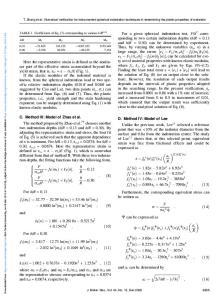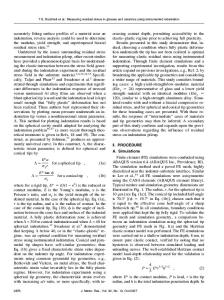Mapping viscoelastic and plastic properties of polymers and polymer-nanotube composites using instrumented indentation
- PDF / 982,087 Bytes
- 14 Pages / 584.957 x 782.986 pts Page_size
- 54 Downloads / 441 Views
An instrumented indentation method is developed for generating maps of time-dependent viscoelastic and time-independent plastic properties of polymeric materials. The method is based on a pyramidal indentation model consisting of two quadratic viscoelastic Kelvin-like elements and a quadratic plastic element in series. Closed-form solutions for indentation displacement under constant load and constant loading-rate are developed and used to determine and validate material properties. Model parameters are determined by point measurements on common monolithic polymers. Mapping is demonstrated on an epoxy-ceramic interface and on two composite materials consisting of epoxy matrices containing multiwall carbon nanotubes. A fast viscoelastic deformation process in the epoxy was unaffected by the inclusion of the nanotubes, whereas a slow viscoelastic process was significantly impeded, as was the plastic deformation. Mapping revealed considerable spatial heterogeneity in the slow viscoelastic and plastic responses in the composites, particularly in the material with a greater fraction of nanotubes.
I. INTRODUCTION
Indentation of polymeric or biological materials or their composites frequently leads to three concurrent modes of contact deformation, characterized by three different variations of the indenter displacement into the material, h, with indentation load, P, and time, t1–12: (V) Viscous deformation, in which the indenter displacement is time-dependent, typically with the rate of displacement varying with load. (E) Elastic deformation, in which the indenter displacement is time-independent and recovers completely on load removal. (P) Plastic deformation, in which the indenter displacement is time-independent and does not recover at all on load removal. Indentation with a spherical probe or flat punch often suppresses plastic deformation such that the deformation is completely viscoelastic,6,11,13–20 or is assumed so for fluid-like materials.14,15,21,22 Under these conditions, viscoelastic correspondence principles23–27 can be used to predict the h(t) response from an imposed P(t) spectrum (or vice versa) if the purely elastic P(h) indentation behavior is known and a time-dependent creep (or relaxation) function is selected for the material. The predictions are frequently framed in terms of superposition integrals. Indentation with the more-commonly used Contributing Editor: Erik G. Herbert a) Address all correspondence to this author. e-mail: [email protected] DOI: 10.1557/jmr.2016.207
pyramidal probes, such as the three-sided Berkovich diamond, usually generates all three of the viscouselastic-plastic (VEP) indentation deformations. Under these conditions, correspondence principles, which rely on material linearity in elastic and viscous constitutive behavior (Hookean and Newtonian, respectively), cannot be used as the plasticity renders the nonviscous component of the deformation nonlinear. Hence, although correspondence methods can incorporate the geometrical nonlinearity of spherical and pyramidal indentatio
Data Loading...











